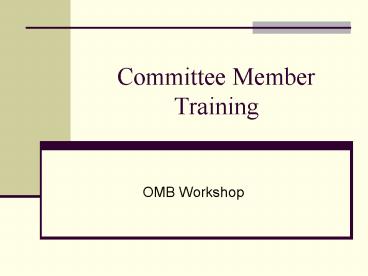Committee Member Training - PowerPoint PPT Presentation
1 / 14
Title:
Committee Member Training
Description:
Does protocol follow AOAC recommendations for AOAC studies? ... Recommendations are forwarded to the committee chair, who ... Members can recommend a topic GR. ... – PowerPoint PPT presentation
Number of Views:55
Avg rating:3.0/5.0
Title: Committee Member Training
1
Committee Member Training
- OMB Workshop
2
Overview
- Why were you selected?
- Experts in the field, as determined by your
peers. - Ability to critically review methods and
technical documents. - Past participation in collaborative studies
- Generous with time, strong-armed by committee
chair, or gullible.
3
Duties and Responsibilities
- Protocol and Manuscript Review
- SLV Protocols
- Is method technically sound?
- Does protocol follow AOAC recommendations for
AOAC studies? - Is the scope and applicability of the method
sufficiently addressed by the samples chosen for
the study? - Will the protocol determine the following
performance characteristics Accuracy, precision
(repeatability), linearity/range, LOD/LOQ,
ruggedness?
4
Duties and Responsibilities
- SLV Manuscripts
- Is method technically sound?
- Was the scope and applicability of the method
sufficiently address by the samples chosen for
the study? - Did the protocol determine the following
performance characteristics Accuracy, precision
(repeatability), linearity/range, LOD/LOQ,
ruggedness? - Can the method be recommended for a collaborative
study?
5
Duties and Responsibilities
- Collaborative Study Protocols
- Is method technically sound?
- Does protocol follow AOAC recommendations for
collaborative studies? - Is the scope and applicability of the method
sufficiently address by the samples chosen for
the study? - Will the protocol determine the reproducibility
of the method?
6
Duties and Responsibilities
- Collaborative Study Protocols
- Did the SLV adequately address the other
performance characteristics of the method? - If not, does the collaborative study protocol
address those parameters? - Is the protocol easy to understand and follow?
- http//www.aoac.org/vmeth/Manual_Part_6.pdf
7
Duties and Responsibilities
- Collaborative Study Manuscript
- Was the protocol followed by the laboratories?
- Does the data support the study directors
conclusions?
8
Participation on Committees
- Provide advice and guidance to the chair, general
referee and/or study director. - Participate in meetings
- Annual meeting
- Phone conferences
9
Participation on Committees
- Vote on Action Items
- Vote on SLV/Collaborative Study Protocols
- Vote on SLV/Collaborative Study manuscripts
- Vote on acceptance of annual committee reports
- Recommendation of method for Official First
Action - Recommendation of method for Final Action
10
Participation on Committees
- Most document review and voting can be
accomplished through AOAC Manuscript Central. - Recommendations are forwarded to the committee
chair, who summarizes for Study Director to
address. - Study directors can respond to comments and
revise protocols and manuscripts - Can lead to several reviews of a document.
11
Participation on Committees
- Members can recommend a topic GR.
- Review the progress of a method through the
validation process and recommend whether to
continue/extend a study, modify a study, or
discontinue a study.
12
Participation on Committees
- Decide on issues such as
- Can a matrix extension be granted for a
particular method? - Requires that a method that has already undergone
a collaborative study process be used as-is for
another matrix not originally included in the
study
13
Use of HorRat
- The HorRat is calculated in both SLV and
collaborative studies. - Horwitz Ratio
- It is a ratio of the actual (measured) RSD vs.
the predicted RSD. - Predicted RSDR 2C-0.15
- C is concentration expressed as a decimal
14
Use of HorRat
- Acceptable values for HorRat are normally
considered 0.5 2. - Is often not applicable to indefinite analytes
(polymers, proteins/enzymes, etc.) and physical
properties. - Through a great deal of effort, HorRats lt0.5 can
sometimes be obtained. - HorRat is a guideline, and is not an absolute
criterion. All factors should be taken into
account when deciding on a methods acceptability.































